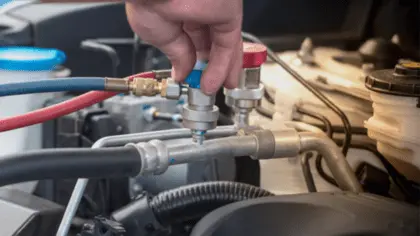A car’s air conditioning unit maintains the cabin temperature to ensure a decent level. Today we are going to look at How to Remove Freon From Car Without Recovery Machine. In essence, Freon has come to represent the term “refrigerant.”
In general, removing Freon or refrigerant is a difficult task that requires the assistance of a professional. However, this time the work was completed without the use of a recovery machine. So, it will be a little bit troubling, but we will succeed for sure.
Simply, switch off the entire cooling and heating system, connect the suction to a limited pressure line, make sure the service valve is closed on the high-pressure end, empty the valve, and then close it. Finally, de-energize the compressor. Anyway, let’s get into it in more detail!
Introduction to Freon
A refrigerant used in air conditioning systems is freon, a non-combustible gas. To keep the engine’s temperature cool, freon is carried inside the engine compartment.
It moves throughout the system and takes in heat from the engine, which makes the car run more smoothly. In essence, the engine circulates and absorbs heat using freon. A temperature drop occurs when it enters the condenser.

How Does Freon Work?
Cold Freon gas is compressed by a compressor in your air conditioner. We also add a small amount of oil to the Freon gas for lubrication.
Freon is essentially a hydrochlorofluorocarbon (HCFC) gas. Freon is often heated up by the AC compressor, which sends the hot gas through cooling coils to cool it and turn it into liquid. The liquid that passes through an expansion valve in your car’s air conditioner continuously reduces its temperature and returns to its original state as a gas.
Related AC compressor: can I drive my car with a bad AC compressor?
Can You Remove Freon From Car?
We frequently remove the freon or refrigerant from the car using an ac recovery unit. But it’s possible to take it out on your own without any equipment.
However, attach an air conditioner recharge hose near the low-side service port to remove the freon. Close the release valve when the pressure gauge reads green and wrap a washcloth around the recharge hose’s end. Simple!
Related air conditioner: air conditioner only works when car is moving
Why Does Refrigerant Need to be Recovered?
The refrigerant, or freon, in the system must be recovered and put into a cylinder that can be refilled. Recovery of refrigerants keeps them from leaking or dispersing into the environment.
The environment is actually affected by freon. This is to let you know that America will no longer manufacture Freon air conditioning systems after 2020.
The AC’s refrigerant coolant needs to be replaced on a regular basis. This extends the duration of the AC and assures that the car’s heating and cooling systems are functioning properly.
Why it is important to retrieve the refrigerant in the system?
The three refrigerants that are most widely used are hydrofluorocarbons (HF), hydrochlorofluorocarbons (CFCs), and HCFCs (HFCs). In order for air conditioning and heating systems to perform, refrigerants are needed for the process of heat transfer. Therefore, it’s essential!
What Happens If Too Much Freon In Car?
Temperatures under the standard are formed by sub-cooling and are generated due to excessive refrigerant or freon in the system. Additionally, it floods the compressor, destroys the other components of your car’s ac system, and lowers the system’s effectiveness.
When the AC is running, you might hear a strange buzzing or humming sound. However, repairing the overcharged one by shutting the vent, releasing some pressure by connecting the hose, and using safety precautions are crucial.
5 Facts To Know About Drain Freon From The Car
- The price to remove and refill the freon will range from $150-$300 at an automobile service center.
- Freon should be securely thrown away. It’s because Freon in the air has become illegal in some nations and states due to its hazardous properties.
- Freon is harmful to the environment and raises greenhouse gases. Therefore, if there is still freon in the air conditioning system, never detach the hoses.
- A certain level of government EPA certification is necessary before freon can be distributed.
- At high risk without a recovery machine, it is suggested to use the recovery machine.
Get Rid of Refrigerant or Freon
Make sure to dispose of the vehicle refrigerant carefully if you plan to reuse it or won’t use it. Check the laws and ordinances for the issue as it’s important. The best idea is to call the Public Works Department, as they can deal with this waste disposal and solutions.
Removing Freon From Car AC With A Recovery Machine
Usually, a recovery machine is used to help us drain the freon. Recovery equipment is a vacuum pump used to drain freon to lower the pressure in the cooling system so that the gas within can quickly escape into the venturi chamber or tank.
In that case, we simply follow the given idea. After this, we will get back to sharing how to remove freon without a recovery machine on your car.
- You will get the low-pressure service port after connecting the service hoses.
- Use the recovery machine.
- When completing the job, disconnect your machine.
- For example, if you have an empty 30-pound tank, you can attach your vacuum pump to it along with the vehicle’s air conditioning system and essentially pump the Freon into the empty tank. Store it, fix your system, and then use the tank to recharge your vehicle again.
Remove Freon Without Recovery Machine
- Make sure you use the protective gear first.
- To ensure the purity of the freon, get a purity detector. Freon into the air is almost prohibited as it’s harsh for the environment.
- Make sure the heating and cooling systems are not left on and turn the thermostat off.
- You will need a wrench and a hex key to remove the freon or other parts from the car.
- Next, ensure the suction side of the air conditioner’s compressor as well as the freon’s lower pressure side. It can be found on the condensing unit.
- Next, link up the suction and low-pressure lines and make sure they are connected.
- Close the valve near the lower pressure area as soon as possible.
- Then, find the wrench or hex key. The service valve must be closed because it shouldn’t be left open.
- Get your compressor, though, and make sure the low pressure is empty. You will need a lower voltage jumper. Now close it perfectly.
- Finally, de-energize your compressor. Done!
Some Other Alternatives to Removing Freon

Spark Plug Hole
- Simply take the wire and wrap it.
- Wrap this section around one end’s tip, then insert it into the hole so that it reaches the bottom.
- Then, the freon will be removed by the suction it creates.
See more: best spark plug for Subaru Outback.
Bicycle Pump
- Choose a place with space between the engine and the firewall.
- Look for a metal line to which you can attach the pump.
- Once you hear a hissing sound, this indicates the freon is leaving the car engine and you can stop pumping air.
- Allow it to cool for at least an hour before recharging.
Vacuum Pump and Rubber Hose Attachments
- The engine won’t overheat with this method, but the recovery machine is the best option.
- It assists you in identifying the freon line that runs along the side of the engine.
- When you hear a hissing sound that indicates the freon is flowing out, attach the vacuum cleaner there and begin pumping the handle.
- Similar to previous methods, allow it to cool for at least an hour before recharging it to allow all the gas to escape from the interior.
Turkey Baster
- Engine spark plugs should be removed.
- Fill the hole by spraying penetrating oil.
- Drain all of the freon in the body with a turkey baster. Simple!
See more: best oil drain valve.
Rubber Hose & Broomstick
- First, remove your car’s engine’s spark plugs.
- Before removing it, spray some oil into that hole to dislodge any debris or rust.
- Once the spark plug has been removed, attach a rubber hose to one of the holes.
- Take a broomstick and place it on the opposite side.
- As soon as you produce suction, keep pumping the vacuum cleaner handle.
- Then, swiftly remove the hose from the spark plug hole and insert it into the exhaust pipe to quickly expel the gas from your car’s system.
- Before recharging it again, let it cool for at least an hour. This is quite risky, so you can avoid these steps.
See spark plugs: how long can you drive with bad spark plugs?
Safety Measures for Removing Freon From Cars
- Make sure you have the appropriate tools and equipment first.
- Start by following the instructions from the manufacturer.
- Choose a place with good ventilation.
- You can do it yourself if your automobile runs on R-12 or R-22.
- Wear protective goggles and hand gloves before taking any action.
- Test the car’s Freon level.
- A companion will be required throughout the procedure.
- It is preferable to let a professional handle the recovery and dumping.
FAQ
How do I release freon pressure from my car?
Although we commonly use recovery machines, you can directly attach an air conditioner recharge hose to the AC’s lower delivery outlet to remove freon from your car’s ac unit.
How much does it cost to remove refrigerant from the car’s AC?
| Work | Cost Level |
| Recharge & Evacuate | $119-$280, based on the type and model of the car and any troubles that come with it. |
| Freon Refill | According to the size of the HVAC unit, it will cost between $100 and $350. |
| Freon Removal | Depending on the tools, labor, and disposal strategies, they will cost $100 to $300. |
Is there an alternative to draining my Freon out of my AC system in my car without a recovery machine?
A recovery machine is what you need; it has a pump, filter, and storage tank. If not, switch off the thermostat, check and link the suction side, close the valve at the lower pressure region, empty the low pressure, and turn off the compressor.
How do you get freon out of a car with a vacuum pump?
For instance, if you are discharging the R134a through the vacuum pump, it’s almost the same effect as just venting it into the atmosphere. If you want to dump freon only, you must particularly be careful to avoid getting burned by r134a when it decompresses out of the system. It’s not a good idea anyway.
Final Words
Dear car rider, removing freon is necessary to keep your vehicle’s health well. As you don’t have a recovery machine, this article has mentioned How to Remove Freon From Car Without Recovery Machine.
However, follow our given instructions like linking up the suction side, closing the valve, and making the pressure low. Additionally, you can use other alternatives like spark plug-in holes, vacuum and bicycle pumps, turkey blasters, rubber hoses, or broomstick ideas. Hope any of them will reach the road of success by draining freon from the car.

